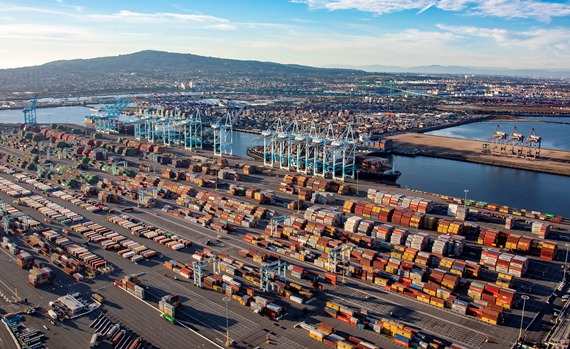-
For containers scheduled to move by truck, ocean carriers will be charged for every container dwelling nine days or more
-
For containers moving by rail, ocean carriers will be charged if the container has dwelled for three days or more
-
Beginning November 1, the ports will charge ocean carriers with cargo in those two categories US$100 per container, increasing in $100 increments per container per day
The ports of Los Angeles and Long Beach in California have announced they will begin imposing a surcharge on ocean carriers for import containers that dwell on marine terminals in a bid to improve cargo movement amid congestion and record volume at the twin ports.
In a joint statement, the ports, the two busiest container terminals in the US, said they will charge ocean carriers for each container that falls into one of two categories.
For containers scheduled to move by truck, ocean carriers will be charged for every container dwelling nine days or more.
For containers moving by rail, ocean carriers will be charged if the container has dwelled for three days or more.
Under the new policy, beginning November 1, the ports will charge ocean carriers with cargo in those two categories US$100 per container, increasing in $100 increments per container per day.
“We must expedite the movement of cargo through the ports to work down the number of ships at anchor,” said Port of Los Angeles executive director Gene Seroka. “Approximately 40% of the containers on our terminals today fall into the two categories. If we can clear this idling cargo, we’ll have much more space on our terminals to accept empties, handle exports, and improve fluidity for the wide range of cargo owners who utilize our ports.”
“With the escalating backlog of ships off the coast, we must take immediate action to prompt the rapid removal of containers from our marine terminals,” said Port of Long Beach executive director Mario Cordero. “The terminals are running out of space, and this will make room for the containers sitting on those ships at anchor.”
“I support the actions taken by the ports of Los Angeles and Long Beach today to charge ocean carriers for lingering containers on marine terminals. These actions aim to expedite the movement of goods and reduce congestion in our ports,” said John D. Porcari, port envoy to the Biden-Harris Supply Chain Disruptions Task Force.
Before the pandemic-induced import surge began in mid-2020, on average, containers for local delivery sat on container terminals under four days, while containers destined for trains dwelled less than two days. Those numbers have increased significantly, making it difficult to clear cargo off the terminals and bring in ships at anchor, said the joint release.
According to a new count by container shipping industry expert Lars Jensen, the number of container vessels in queue at the start of this week outside Los Angeles/Long Beach moved up to 79 compared to the 70 vessels just five days ago.
Fees collected from dwelling cargo will be re-invested by the two ports for programs designed to enhance efficiency, accelerate cargo velocity, and address congestion impacts throughout the San Pedro Bay, the ports’ statement said.
The Port of Los Angeles and Port of Long Beach are the two largest container ports in the US, first and second, respectively, and combined are the ninth largest port complex in the world.
Photo from Port of Los Angeles website





